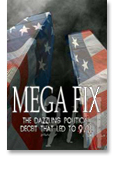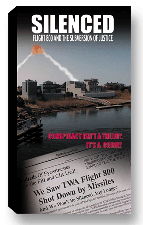Did Clarke’s “Almost War”
Cause The Real One?
![]()
January 31, 2008 - WND.com
© Jack Cashill
by Jack Cashill
This is the sixth in a six-part series detailing the risks to American national security if Barack Obama (or Hillary Clinton) should ever choose to let Richard Clarke back into government. Clarke is currently one of Obama’s top national security advisors.
"If they've been secretive in the past, they'll be secretive as president," Barack Obama said on the stump recently in reference to Bill and Hillary Clinton.
But the keeper of the Clintons’ deepest secret now serves not the Clintons but Obama himself, as one of the candidate’s top national security advisors, the former counter-terrorism czar, Richard Clarke.
In the way of background, Clarke had a major job on his hands in August 1996. Just months before an election that his boss, Bill Clinton, had already sewn up, the nation was in near crisis.
On July 17, 1996, TWA Flight 800 had blown up off the coast of Long Island, killing all 230 people on board. Four weeks after the crash, The New York Times summed up the state of the investigation.
"Now that investigators say they think the center fuel tank did not explode,” reported the Times on August 14, “they say the only good explanations remaining are that a bomb or a missile brought down the plane."
At just about this same time, Clarke reports, he went with FBI buddy John O’Neill to “the giant hanger in Bethpage, Long Island” where the remains of TWA Flight 800 were being examined.
In fact, that giant hangar was located in Calverton, Long Island, nearly fifty miles east. But that is the least of the factual problems that plagued this presumed visit.
While wandering through the facility by himself, Clarke casually stopped to talk to a random technician. He recounts this conversation in his book, Against All Enemies, in a chapter titled, “The Almost War, 1996,”
“So this is where the bomb exploded?” Clarke asks. “Where on the plane was it?”
Clarke is in for a surprise. The technician tells him, “It wasn’t a bomb.” He adds, “See the pitting pattern and the tear. It was a slow, gaseous eruption, from inside.”
Clarke’s technician may have been the only one on Long Island who believed this, but in this one chance encounter Clarke managed to distill the essence of the final cover story months. if not years, before the NTSB did.
As he tells it, Clarke returned to Washington that same day and shared his exploding fuel tank theory with Clinton chief of staff Leon Panetta and NSA director Tony Lake, even sketching the 747 design.
“Does the NTSB agree with you,” Lake reportedly asks Clarke. “Not yet,” Clarke admits, but adds the telling comment, “We were all cautiously encouraged.”
They were encouraged for an understandable reason: mechanical failure made the planned “all-out war with Iran” an “almost war.” This was especially welcome news because the White House could not be sure Iran was responsible.
TWA Flight 800 just happened to be blown out of the sky on the politically inconvenient date of July 17, Saddam’s evil Fourth of July, National Liberation Day in Iraq, a defiant terrorist state that the White House had been ducking since the bombing of the World Trade Center three years prior.
By late September, the White House had succeeded, despite a lack of evidence, in establishing Clarke’s mechanical failure scenario as the reigning explanation for the plane’s destruction.
To make this explanation stick, however, the administration had to negate the one kind of evidence that could not be manipulated or destroyed: that of the 270 official FBI eyewitnesses to an apparent missile strike.
This would not be easy. Many of these witnesses were knowledgeable and precise. Some were military or aviation professionals, like Witness #73.
In her interview, on July 30, 1996, she told an FBI agent that she was standing on the beach when she noticed a 747 “level off.” She then saw a “red streak” with a “light gray smoke trail” move up towards the airline at a forty-five-degree angle.
Then, the “red streak went past the right side and above the aircraft before arcking [sic] back down toward the aircrafts [sic] right wing.” She watched “the front of the aircraft separate from the back” and told this to the FBI before the public knew that the front end of the plane had, in fact, broken off.
To discredit the eyewitnesses, many of whom were as specific and accurate as #73, the CIA created a video that simulated the plane’s presumed final minutes.
“What witnesses saw as a streak of a missile going up towards the aircraft,” writes Clarke approvingly of the CIA simulation, “was actually a column of jet fuel from the initial explosion and rupture, falling and then catching fire.”
The FBI showed this video once and closed the case. Yes, of course, the 270 eyewitnesses had all been tricked by an optical illusion. A quiescent media accepted the explanation without even asking why the CIA had involved itself in a domestic airplane crash.
Because of the media’s indifference, the question lingers as to who brought the normally contentious CIA and FBI together on so critical and corrupt a project as the CIA simulation.
The person responsible had to have been tight with the Clintons, conversant with the CIA and FBI, and willing to do some dirty work. The list of suspects is mighty short, and at the top of the list is Clarke.
To be fair, Clarke never takes responsibility for the video himself. This job was a little too dirty to boast about. In a post-9/11 New Yorker article, he credits the FBI’s O’Neill for discovering that that the “ascending flare” must have been something else, like “the ignition of leaking fuel from the aircraft.”
In that same article, however, Clarke reports that it was O’Neill who persuaded him that TWA 800 was out of range of the Stinger. In the book, two years later, it was he who persuades O’Neill.
In either case, O’Neill was not around to defend himself. He died in the World Trade Center on September 11. Clarke dedicated the book to him.
Clarke likes the grand gesture. "Those entrusted with protecting you failed you, and I failed you," Clarke would weepily confess to the American public through the medium of the 9/11 Commission—before, of course, shifting the blame to the Bush administration.
Clarke has much to apologize for, and he knows it. Encoded in Against All Enemies is a cryptic concession about the consequences of deception.
The TWA Flight 800 disaster, he admits, “had not provided the political circumstances needed for the massive change in how the federal government performed aviation security.”
Clarke further concedes that the White House aviation commission, inspired by the TWA 800 disaster and chaired by Al Gore, “had not been sufficiently ambitious about the job of airport security and passenger screening.”
What he does not admit, of course, is that the corruption of the TWA 800 investigation vitiated the political will necessary to make changes. Nor does he admit his own role in that corruption.
Worse, the successful suppression of the truth meant that the subject of TWA Flight 800—and by extension, aviation security—could not be exposed to light.
To his humble credit, Clarke is unique among Clinton veterans in his willingness to talk about TWA Flight 800 and the harrowing days of the “Almost War, 1996.”
In their respective memoirs, Bill Clinton dedicates a paragraph to this momentous subject, the FBI’s Louis Freeh two sentences, Hillary a third of a sentence, Dick Morris two words, advisor George Stephanopoulous and the CIA’s George Tenet—not a word.
This pattern begs a critical question. If this disaster is too sensitive to discuss even now, even by memoirists in confessional mode, must not that sensitivity have deformed aviation-related planning in the years before September 11.
Clarke’s testimony before the 9/11 Commission suggests that the answer is definitely “yes.”
He told the Commission that the "knowledge about al-Qaeda having thought of using aircraft as weapons" was relatively old – "5-years, 6-years old."
He then asked that intelligence analysts "be forgiven for not thinking about it given the fact that they hadn't seen a lot in the five or six years intervening about it."
What Clarke fails to understand is that the forgiveness, which he so publicly seeks, comes only after confession. And Obama, before his next attack on the Clinton’s secretiveness, should demand one.

Previous articles in this series:
![]()
Get more info:

- About Mega Fix: The Dazzling Political Deceit that Led to 9/11 (DVD) -
- Buy the Mega Fix DVD -
![]()

- About Silenced: Flight 800 and the Subversion of Justice (DVD) -
-Buy the Silenced DVD-
![]()
Part 2
Part 3
Part 4
Part 5
Part 6
